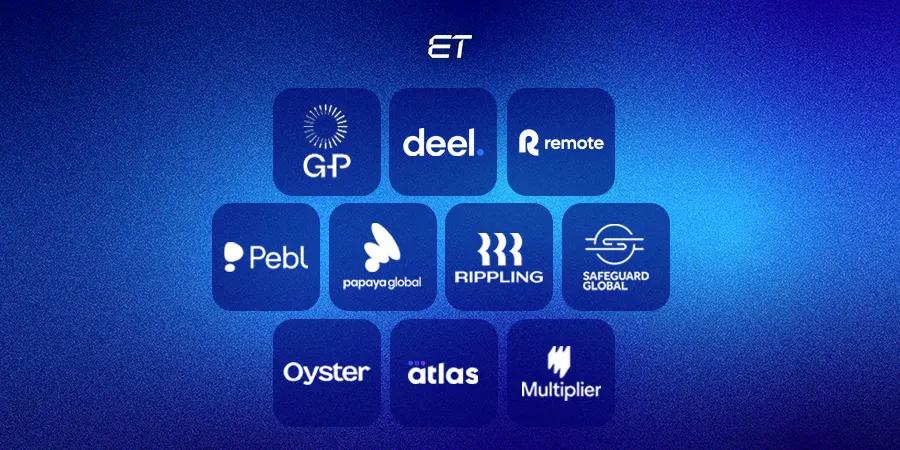
10 IT Cost Optimization Strategies Every CFO Should Know
IT spending feels like a black box to you? The numbers come in, budgets go out, and somewhere in between, efficiency leaks happen. The worse part? Those leaks are invisible until the quarter-end review. But, (drumrolls) IT cost optimization changes that.
Simply put, cost optimization is the act of putting structure, data, and accountability into every investment. It’s one of the fastest ways to free up budget without delaying growth. And with the global IT spending reaching approx. USD 5 trillion, you need to make every penny count (as your competitors might be all in).
If you do it right, IT cost optimization strategies aren’t one-off cost-cutting sprints. In fact, they keep your IT aligned with business goals.
So, brace up. In the next few minutes, you’ll see 10 strategies IT service management cost optimization leaders use to control costs, boost efficiency, and deliver measurable ROI.
Want to get on a call instead? Let’s discuss how we can help save costs and become your go-to vendor.
1. Get Full Visibility into IT Spend

Think of this tip as your IT cost optimization starting line.
If you don’t have a crystal-clear view of where every IT dollar goes, you’re working blind. And no, a generic monthly expense report from finance isn’t enough. Those numbers lump costs together and hide the problem areas.
A true IT cost optimization framework starts with building a single source of truth for IT spend. This means:
- Consolidating data from finance, procurement, and IT service management systems.
- Breaking spend down by department, project, service, and vendor.
- Including both CapEx (infrastructure, hardware) and OpEx (cloud, SaaS, managed services).
When IT service management industry cost optimization leaders do this, they uncover dozens of small leakages that, together, drain millions over time.
For example: Unused SaaS licenses quietly renewing, redundant support contracts, or inflated cloud storage tiers that nobody downgraded.
Why CFOs should care:
Full visibility doesn’t lets you link IT costs directly to business outcomes. For instance, if your cloud analytics service costs $50K a quarter but is driving $500K in revenue opportunities, you’ll know it’s worth keeping.
Action steps
1. Integrate your finance system with your ITSM tool (like ServiceNow, Jira Service Management, or Freshservice).
2.Tag every expense by service, function, and business owner.
3.Set up a quarterly spend review meeting where IT, finance, and operations go through the top 10 expense lines together.
Pro tip: The best IT cost optimization companies provide automated dashboards that track spend in near real time, so you can make adjustments before invoices hit the finance team.
Speaking of cost optimization, did you know the right IDE helps to keep your budget under control?
2. Audit and Rationalize Your Application Portfolio
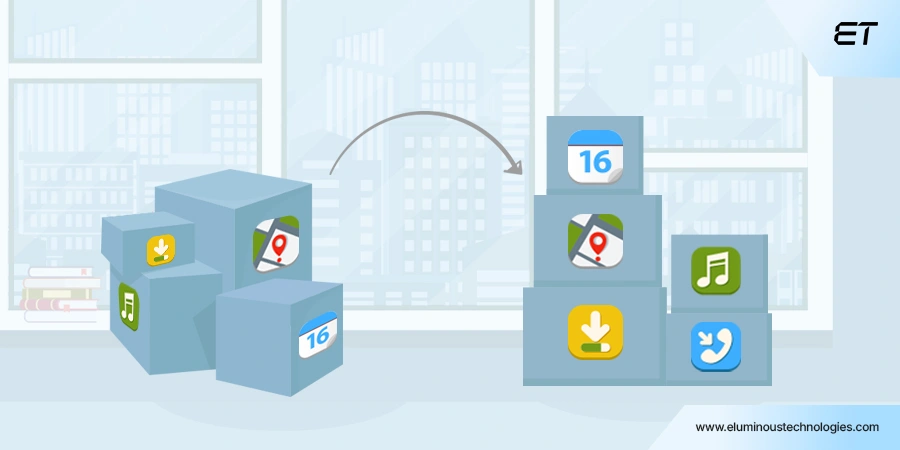
Bloated application stacks are one of the trickiest drains on IT budgets. Over time, teams add tools for every need: a new project management app here, a specialized analytics platform there and before you know it, you’re paying for three systems that all do 80% of the same job.
A disciplined audit is key to IT cost optimization because reduces hidden costs like user training, integrations, and support contracts.
What this means in practice:
- Inventory everything: On-premises software, SaaS subscriptions, in-house apps.
- Track usage data: Most tools have built-in analytics showing active users and frequency of use.
- Score business value: Question whether an app is essential? Does it deliver ROI? Does another tool already do this?
When IT service management cost optimization leaders run an application rationalization program, they can cut 15 – 30% of software costs in the first year alone without impacting productivity.
For example:
- Merging three separate reporting tools into one enterprise-grade BI platform.
- Eliminating shadow IT apps that duplicate licensed software already provided.
- Downgrading unused premium SaaS tiers to more cost-effective plans.
Why CFOs should care:
Every redundant tool is a recurring cost you’re not getting full value from. Worse, fragmented apps mean fragmented data which slows decision-making and increases risk. A lean, well-integrated stack reduces both cost and complexity.
Action steps
1. Partner with IT to pull license usage data for every application.
2. Flag underutilized or duplicate tools and create a ‘keep, cut, consolidate’ list.
3. Negotiate bulk licensing deals or vendor consolidation for remaining apps.
Pro tip: The best IT cost optimization companies use application rationalization as an ongoing process, reviewing portfolios at least twice a year to prevent bloat from creeping back.
3. Optimize Cloud Usage and Spend
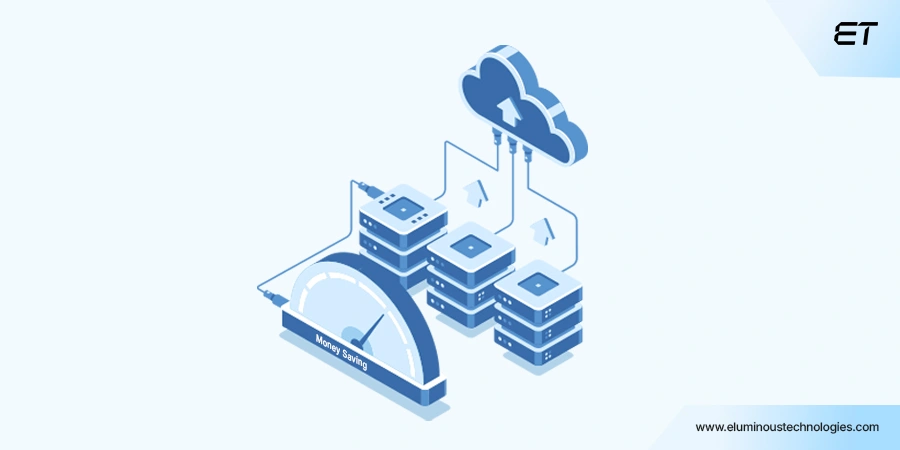
Cloud was sold as the cheaper, more flexible alternative to on-premises infrastructure.
But today, for many organizations, it’s become the opposite. Without active management, pay-as-you-go quickly turns into pay-for-more-than-you-need.
IT cost optimization in the cloud is about matching resources to actual demand, eliminating idle capacity, and locking in savings where predictable workloads allow.
What this means in practice:
- Right-size instances: Avoid overprovisioning compute, storage, or database capacity.
- Use reserved instances: For steady workloads to get significant discounts.
- Turn off idle resources: Staging servers, test environments, or unused storage buckets that quietly rack up fees.
- Monitor egress costs: Data transfer between regions or providers can add up fast.
IT service management industry cost optimization leaders treat cloud like a utility.
For example: One mid-size SaaS provider can reduce annual AWS costs by automating shutdowns for non-production environments outside working hours and cleaning up unattached storage volumes.
Why CFOs should care:
Cloud spend is one of the few IT budget lines that can grow without headcount increases or capital purchases. So, continuous monitoring and optimization is vital to keep it under control and predictable.
Action steps
1. Implement a cloud cost management platform (e.g., AWS Cost Explorer, Azure Cost Management, CloudHealth).
2. Set budgets and automated alerts for resource usage.
3. Review and adjust provisioning monthly. Don’t wait for the quarterly invoice.
Pro tip: The best IT cost optimization companies introduce a FinOps team or governance layer that brings finance, IT, and operations together for monthly cloud spend reviews turning a reactive process into a proactive one.
Optimize costs by mastering your cloud’s scalability. Our blog will help you out.
4. Consolidate and Negotiate Vendor Contracts
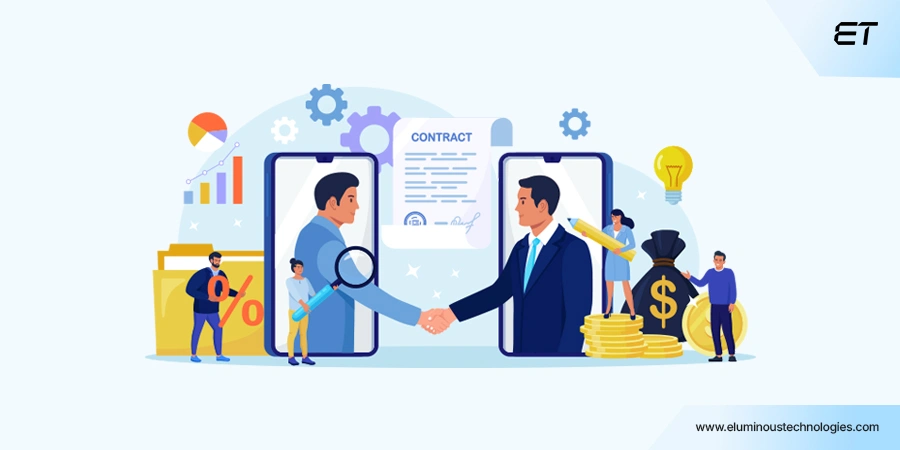
Vendor sprawl is a quiet budget killer.
Different departments sign separate contracts with the same or similar vendors, often at different rates. Multiply that across software, hardware, cloud, and managed services, and you’re leaving serious money on the table.
IT cost optimization here means pulling all vendor relationships into one view, consolidating where possible, and negotiating from a position of scale.
What this means in practice:
- Identify overlaps: Multiple contracts for similar tools, or separate licenses for the same product in different departments.
- Bundle purchases: Larger volume often means better pricing.
- Align contract terms: Syncing renewal dates lets you negotiate multiple agreements at once.
- Push for value-adds: Extended support, training credits, or free feature upgrades as part of the deal.
IT service management cost optimization leaders don’t wait until renewal time to negotiate. They build a 6 – 9 month lead time into procurement planning, so vendors know they’re not locked in.
For instance, an enterprise client can save over $1.2M in a single cycle by consolidating five separate SaaS contracts into one enterprise agreement and locking in a three-year rate freeze.
Why CFOs should care:
Consolidation is about reducing the overhead of managing multiple vendor relationships and invoices. This aspect improves compliance and reduces the risk of shadow contracts.
Action steps
1. Create a master vendor list with spend, renewal dates, and service owners.
2. Identify opportunities to merge contracts under one umbrella agreement.
3. Use competitive bids to strengthen your negotiating position.
Pro tip: The best IT cost optimization companies maintain a vendor scorecard tracking service quality, cost stability, and contract flexibility. This way, CFOs can make renewal decisions based on performance, not just price.
5. Automate Routine IT Processes
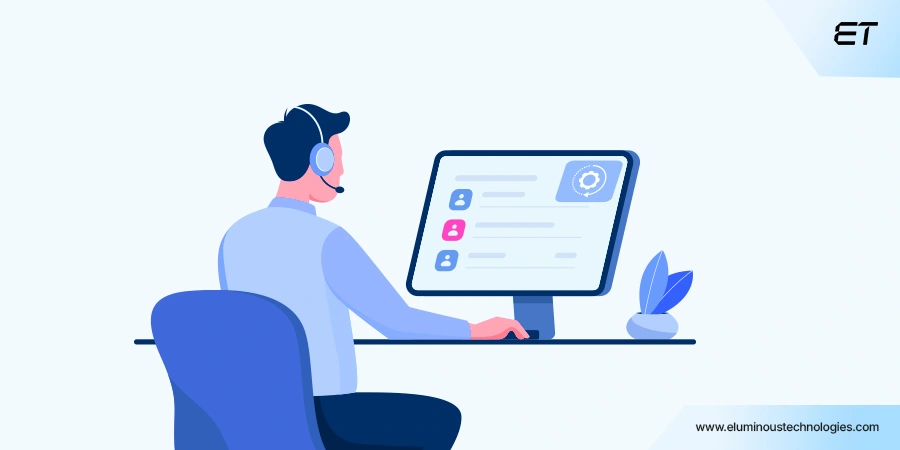
Repetitive IT tasks impact man-hours and budgets faster than most CFOs realize.
For instance, password resets, software provisioning, system monitoring all seem minor individually, but together, they consume thousands of staff hours each year. That’s high-cost labor spent on low-value work.
IT cost optimization in this area means deploying automation to handle the repetitive, predictable processes so skilled IT staff can focus on strategic projects.
What this means in practice:
- Self-service portals for password resets, onboarding, and basic troubleshooting.
- Automated patch management to keep systems secure without manual intervention.
- Monitoring and alert automation for systems and networks to flag issues before they escalate.
- Workflow automation in IT service management platforms to reduce ticket handling time.
IT service management industry cost optimization leaders often measure automation’s impact in reclaimed hours, not just reduced spend.
For example: Automating routine account provisioning for new hires can save 3 – 4 hours per employee which, in a 1,000-person organization, is hundreds of labor hours freed up annually.
Why CFOs should care:
Automation isn’t just about efficiency; it’s about reallocation. Freeing IT staff from repetitive work means fewer overtime costs, reduced error rates, and more time for projects that actually drive revenue or efficiency gains.
Action steps
1. Identify top 5 repetitive IT tasks by volume and cost.
2. Implement automation through ITSM tools like ServiceNow, Jira Service Management, or Freshservice.
3. Track pre- and post-automation KPIs to quantify ROI.
Pro tip: The best IT cost optimization companies approach automation incrementally, starting with high-volume, low-complexity tasks, then scaling to more complex workflows once the ROI is proven.
Not just routine IT, you can even automate DevOps efficiently. Our blog unravels the answers.
6. Extend Hardware and Infrastructure Lifecycles
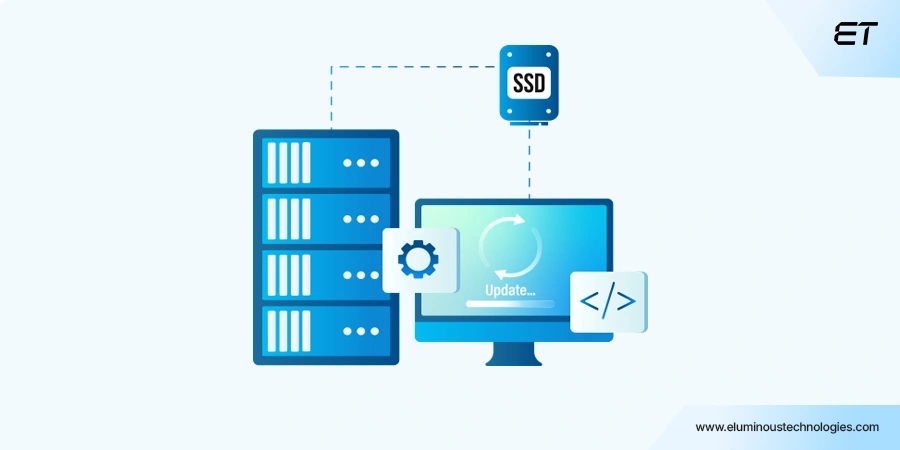
Too many organizations replace hardware on fixed timelines without checking if the equipment is still performing well. That’s money out the door for upgrades you might not need yet.
IT cost optimization here means maximizing the useful life of assets without compromising reliability or security.
What this means in practice:
- Condition-based replacement: Replace when performance or failure rates dictate, not just when a lease expires.
- Upgrades over replacements: Adding RAM or SSDs can extend desktop and laptop life by 12 – 24 months at a fraction of replacement cost.
- Refurbishment programs: Reassigning retired devices to less resource-intensive roles within the company.
- Virtualization and containerization: Reducing the physical server footprint to delay new hardware purchases.
IT service management cost optimization leaders pair this with proactive maintenance schedules.
Why CFOs should care:
Every year you delay a major hardware refresh without sacrificing performance is a direct budget win. Plus, extended lifecycles mean less e-waste, aligning with ESG commitments.
Action steps
1. Review current asset lifecycle policies with IT and adjust to a condition-based approach.
2. Implement monitoring tools to track device health and performance.
3. Budget for upgrades and maintenance that extend lifespan instead of full replacements.
Pro tip: The best IT cost optimization companies combine lifecycle extension with vendor warranty negotiations, getting extended support for older assets at a lower cost than new purchases.
7. Implement Chargeback or Showback Models
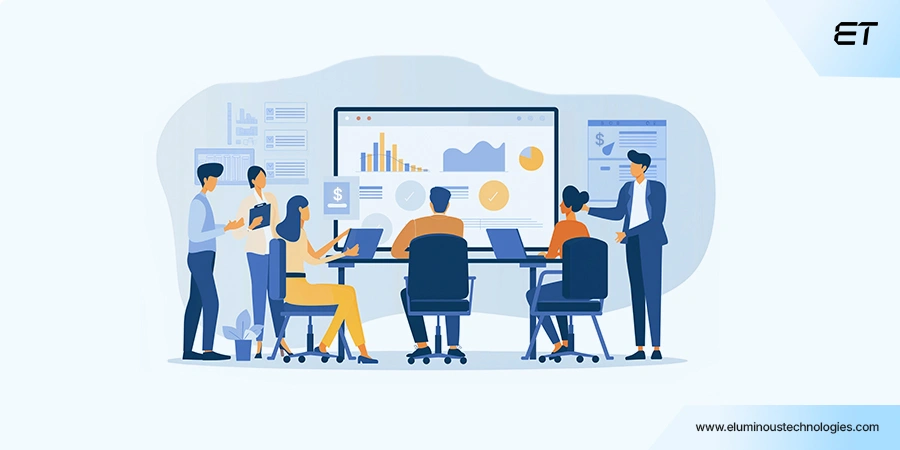
One reason IT costs spiral is that departments treat technology like a free buffet. They consume services without ever seeing the bill. That changes fast when you introduce chargeback (billing departments for actual usage) or showback (showing them what their usage costs without billing).
Both models increase cost awareness and accountability, making them critical pillars of any IT cost optimization framework.
What this means in practice:
- Chargeback: Allocate IT costs directly to the department, project, or business unit that uses them. If marketing spins up an expensive analytics instance in the cloud, that line item appears on their budget.
- Showback: Share detailed cost reports by department, highlighting usage trends and spend drivers, but without transferring the cost. It’s often a precursor to chargeback.
- Granular tracking: Tie costs to actual consumption like CPU hours, storage GBs, license counts.
IT service management industry cost optimization leaders use these models to shape behavior.
Why CFOs should care:
When cost accountability is transparent, departments think twice before provisioning unnecessary resources or holding onto underused licenses. That translates into fewer budget surprises and a leaner IT spend profile.
Action steps
1. Work with IT to identify systems capable of tracking usage by department.
2. Start with a showback program for 3–6 months to establish awareness.
3. Move to chargeback once departments understand and accept the model.
Pro tip: The best IT cost optimization companies pair chargeback/showback with dashboards in the ITSM system, so business leaders can see their spend in near real time instead of waiting for quarterly reports.
8. Standardize and Streamline IT Service Management

Fragmented IT service delivery is expensive.
Different teams using different processes, tools, or service catalogs end up solving the same problems in multiple ways.
IT cost optimization here means creating standardized processes across your IT service management (ITSM) environment so work is handled with minimal waste.
What this means in practice:
- Unified service catalog: One place where all IT services from password resets to hardware requests are logged and tracked.
- Standard operating procedures (SOPs): Clear, documented steps for handling recurring issues.
- Centralized ticketing and tracking: No more siloed helpdesks; everyone works from the same ITSM platform.
- Performance metrics: Track resolution time, first-contact resolution rate, and backlog to identify inefficiencies.
IT service management cost optimization leaders cut support costs by 15 – 25% by removing redundant workflows and consolidating support into a single queue.
For example: A manufacturing firm can save considerable money annually by merging three separate IT helpdesks into a unified ITSM system with standard workflows.
Why CFOs should care:
Standardization reduces labor costs, improves resource utilization, and shortens downtime. These directly impact operational efficiency and profitability.
Action steps
1. Audit current ITSM processes and tools across all departments.
2. Migrate to a unified ITSM platform with a standardized service catalog.
3. Train all IT support teams on the same SOPs and performance metrics.
Pro tip: The best IT cost optimization companies embed cost tracking into ITSM workflows, so every ticket tracks the associated cost. This aspect gives CFOs visibility into the true cost of IT operations.
9. Optimize IT Procurement Practices

IT procurement is about buying the right way, at the right time, from the right vendor. Poor procurement discipline leads to overspending, misaligned purchases, and vendor lock-in that limits negotiating power.
IT cost optimization in procurement focuses on centralizing purchasing, enforcing standards, and leveraging competitive bidding.
What this means in practice:
- Centralized purchasing authority: All IT purchases go through a single, trained procurement team rather than multiple departments placing ad-hoc orders.
- Standardized specs: Avoid custom requests that increase costs and complicate maintenance.
- Competitive bidding: For large purchases, solicit quotes from multiple vendors to keep pricing competitive.
- Leverage timing: Many vendors offer better deals at quarter-end or year-end when they’re trying to meet sales targets.
IT service management industry cost optimization leaders integrate procurement into the IT cost optimization framework itself, using spend analytics to guide purchasing decisions.
Why CFOs should care:
Procurement inefficiency is often invisible until an audit. Streamlined purchasing prevents redundant purchases that increase long-term support.
Action steps
1. Consolidate IT purchasing under a centralized procurement policy.
2. Require multiple bids for any purchase above a set threshold.
3. Use spend analytics to inform contract timing and negotiation.
Pro tip: The best IT cost optimization companies help clients create procurement playbooks. These are step-by-step processes that standardize buying decisions, maintain compliance, and maximize cost savings.
You can save time and just send us an RFP. Here’s a resource that helps you craft one.
10. Continuously Monitor and Improve IT Cost Performance
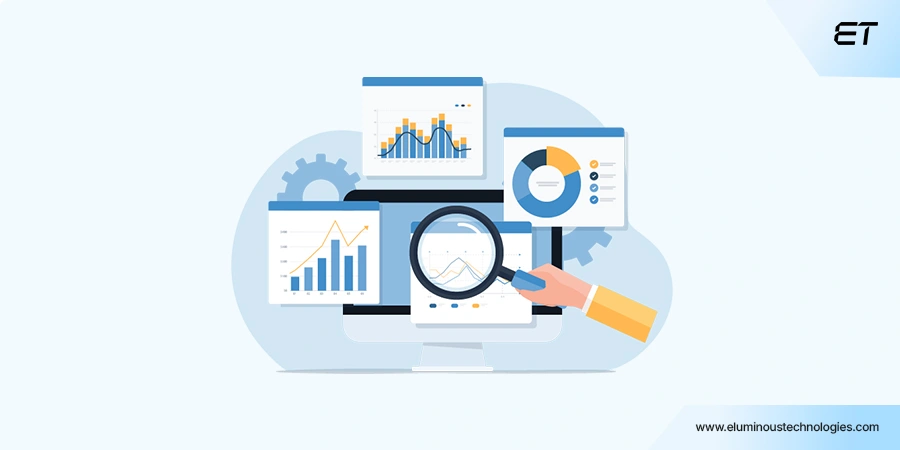
Even the best IT cost optimization strategies lose effectiveness if they’re treated as one-and-done projects. Costs creep back in, new technologies get adopted without oversight, and vendors quietly increase rates. The only way to lock in savings is to make optimization a continuous discipline.
What this means in practice:
- KPIs for cost efficiency: Track metrics like cost per user, cost per service ticket, cloud cost per workload, and application utilization rates.
- Quarterly cost reviews: Finance, IT, and operations meet to review spend trends, contract performance, and savings opportunities.
- Benchmarking: Compare your IT spend ratios with industry peers to identify areas of overspend or underinvestment.
- Process audits: Regularly revisit earlier strategies like vendor consolidation, application rationalization, and automation.
IT service management cost optimization leaders use continuous monitoring platforms that automatically flag anomalies like sudden spikes in storage costs.
For instance, a retail chain can avoid considerable overspend when its monitoring system detects a runaway cloud process within 24 hours.
Why CFOs should care:
Without ongoing measurement, savings evaporate. Continuous improvement ensures your IT cost optimization framework evolves with business needs, market changes, and technology shifts.
Action steps
1. Define 4 – 6 core IT cost KPIs and track them monthly.
2. Assign ownership for monitoring and reporting these metrics.
3. Conduct an annual, full-scope IT cost audit to reset benchmarks and uncover new opportunities.
Pro tip: The best IT cost optimization companies position themselves as long-term partners, embedding monitoring and optimization into governance.
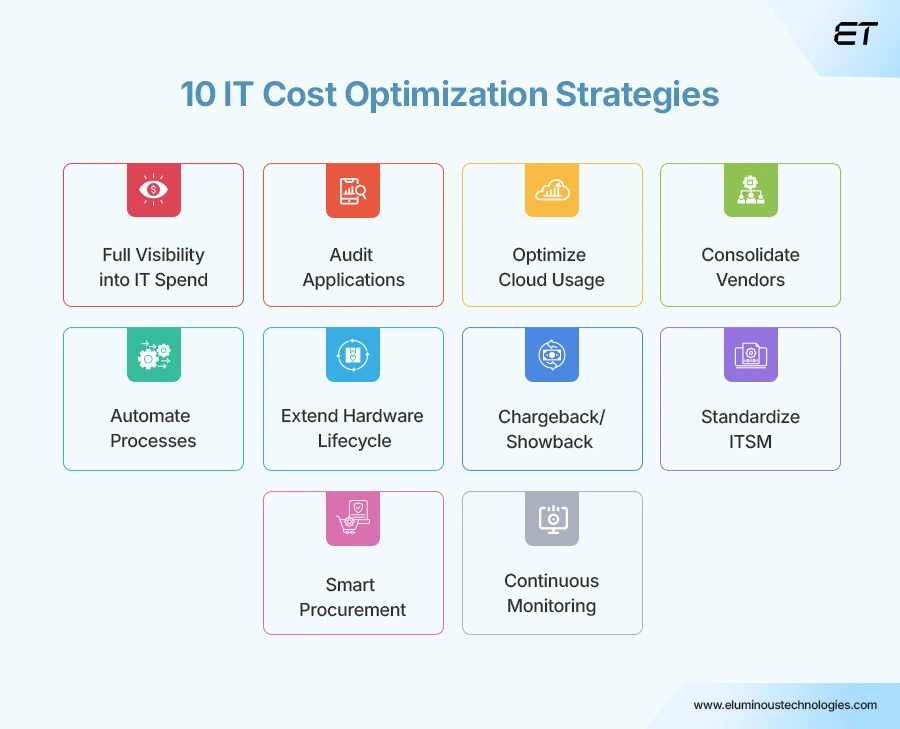
To Sum Up
IT cost optimization is all about making every dollar deliver measurable value. The strategies above give CFOs a clear, actionable path to reduce waste, improve efficiency, and align IT with business growth. The competitive edge comes from execution and discipline, not theory.
If your IT spending feels like it could work harder for your business, it’s worth partnering with experts who live and breathe cost efficiency.
So, let’s talk about making your IT spend deliver more!
Over 20 years, we have helped develop software and cut IT spending for our clients.



